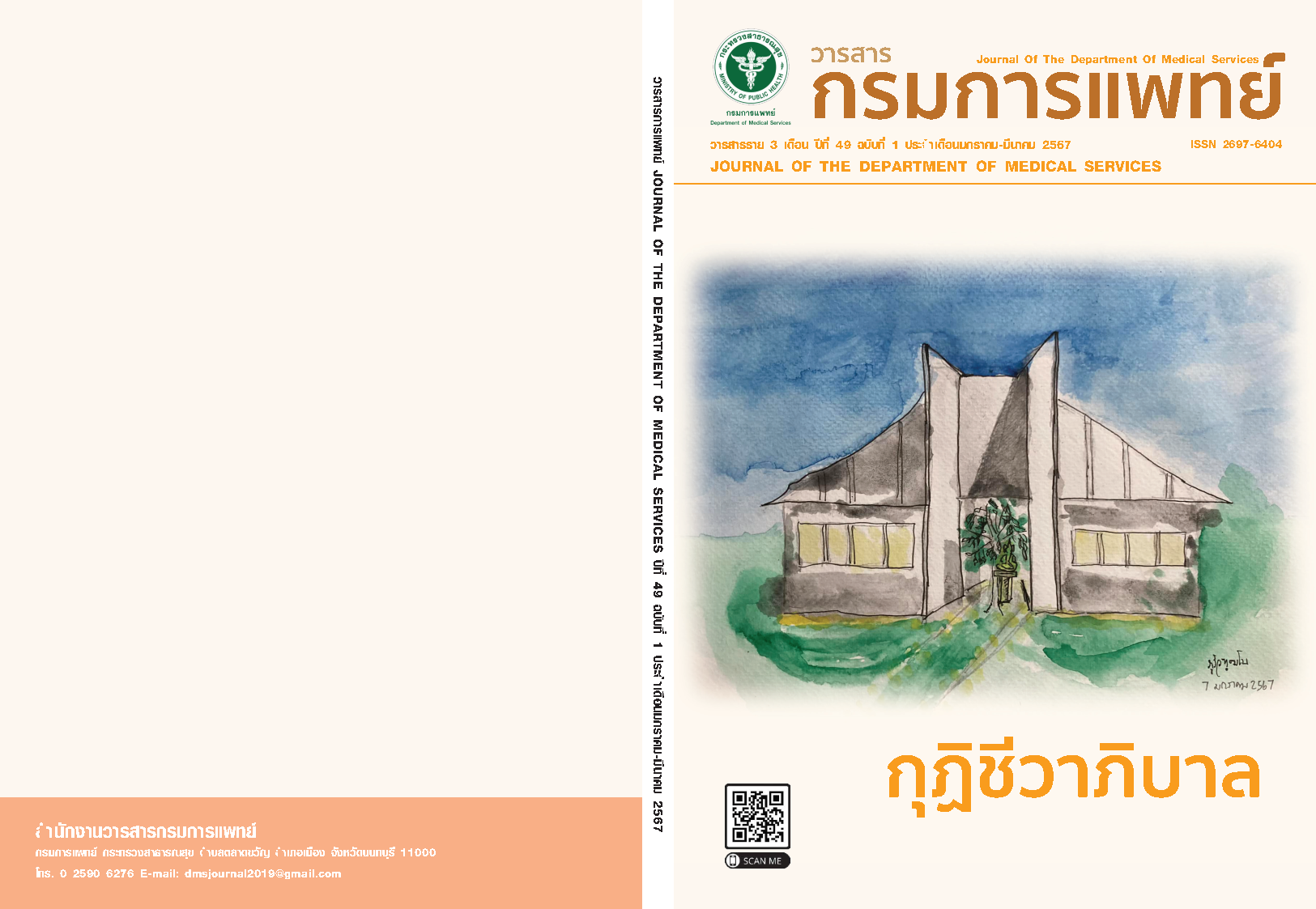Listening Behavior, Prevalence of Ear Diseases and Hearing Loss in Primary Elementary School Children Who Studied Online (A Prospective Pilot Study)
Keywords:
Hearing loss, Hearing screening, Listening behavior, Personal listening devicesAbstract
Background: During the COVID-19 pandemic, schools changed their teaching modalities to online modes. Increasing the duration of using and listening to personal listening devices (PLDs) was expected. The risk of noise-induced hearing loss should be increased. Objective: 1. To assess hearing health and listening behavior with earphones. 2. To evaluate the prevalence of hearing loss and ear diseases. Method: A prospective pilot study was performed at Chiang Mai Rajabhat University Demonstration School between June and August 2022. The data of primary elementary school children including hearing health and listening behaviors were collected with questionnaires answered by parents. Otoscopies and hearing tests with distortion product otoacoustic emissions (DPOAEs) were performed. Results: Data from 228 parents showed that duration of listening to PLD on day with online-studying was significantly longer than on day with no online-studying (p-value < .0001). Of 225 students who had ear examinations, 49.78% were boys and 50.22% were girls. The average age was 7.46±0.87 years. Otoscopic findings revealed occluded cerumen (27.55%) and partially occluded cerumen (13.33%). Other findings had only one student in each finding (2.20% in total; 95% CI: 0.7 - 5.1) and those were ear drum perforation, myringosclerosis, air bubbles behind the ear drum, dull or retracted ear drum, and foreign body in the ear canal. DPOAE results in 208 students with normal and seen ear drums showed normal in both ears at 97.60%, abnormal in either ear at 1.9%, and abnormal in both ears at 0.49%. Conclusion: The students increased their use of PLDs during the COVID-19 pandemic. Otoscopic findings revealed 40.88% of the students had impacted cerumen. DPOAE results showed an abnormality in only 2.4%. Though there was a low prevalence of ear diseases and hearing loss, safe listening programs should be implemented to prevent irreversible damage to the inner ear.
References
Department of Empowerment of Persons with Disabilities. Disabled person situation report. [internet] 2023 [cited 2023 Mar 10]. Available from: https://dep. go.th/th/law-academic/knowledge-base/disabledperson-situation.
Itano CY, Johnson C, Carpenter K, Brown AS. Outcomes of children with mild bilateral hearing loss and unilateral hearing loss. Seminars in Hearing 2008;29 (2):196–211.
World Health Organization. Childhood hearing loss: strategies for prevention and care. [internet] 2016 [cited 2023 May 10] Available from: https://www.who.int/ docs/default-source/imported2/childhood-hearingloss--strategies-for-prevention-and-care.pdf?s fvrsn=cbbbb3cc_0
Hearing screening: considerations for implementation. Geneva: World Health Organization; 2021.
Chowsilpa S. Noise-induced hearing loss and otitic barotrauma. In: Sittitrai P, Chaiyasate S, Kaewsiri S, Chowsilpa S, editors. Otolaryngology Handbook for general practitioner. 4th edition. Chiang Mai: Langiagc Center & Advertisement Co.,Ltd; 2017. p.335-46.
Yimtae K, Potaporn M, Kaewsiri S, editors. Guideline for newborn hearing screening in Thailand. Bangkok: Rajavithi Hospital, Department of Medical Services, Ministry of Public Health; 2019.
Chayarpham S, Stuart J, Chongsuvivatwong V, Chinpairoj S, Lim A. A study of the prevalence of and risk factors for ear diseases and hearing loss in primary school children in Hat Yai, Thailand. J Med Assoc Thai 1996;79(7): 468-72.
Noipayak P, Piyasilp V, Ningsanond W, Ungthavorn P, editors. Guideline in Child Health Supervision. 1st edition. Bangkok: Sappasan Co.,Ltd; 2014.
Results of ear examination in the budget year 2022. School Health system, Chiang Mai Provincial Public Health Office. [internet] 2022 [cited 2022 Apr 17]. Available from: https://school.chiangmaihealth.go.th /web/index.php?r=report%2Freport&1%5Breport_ id%5D=26&1%5Bb_year%5D=2022.
Torres-Russotto D, Landau WM, Harding GW, Bohne BA, Sun K, Sinatra PM. Calibrated finger rub auditory screening test (CALFRAST). Neurology 2009;72(18): 1595-600.
Nunes ADS, Balen SA, Souza DLB, Barbosa IR. Prevalence of hearing loss and associated factors in school-age individuals in an urban area of Northeast Brazil. Int Arch Otorhinolaryngol 2020;24(3):e330-7.
Fitzpatrick EM, McCurdy L, Whittingham J, Rourke R, Nassrallah F, Grandpierre V, et al. Hearing loss prevalence and hearing health among school-aged children in the Canadian Arctic. Int J Audiol 2021;60 (7):521-31.
le Clercq CMP, Goedegebure A, Jaddoe VWV, Raat H, Baatenburg de Jong RJ, van der Schroeff MP. Association between portable music player use and hearing loss among children of school age in the Netherlands. JAMA Otolaryngol Head Neck Surg 2018;144(8):668-75.
Dhand NK, Khatkar MS. Statulator: An online statistical calculator. Sample Size Calculator for Estimating a Single Proportion. [internet] 2014 [cited 2021 Sep 27] Available from: http://statulator.com/SampleSize/ss1P. html
Prieve B, Fitzgerald T. Otoacoustic Emissions. In: Katz J, Chasin M, English K, Hoo LJ, Tillery KL. Handbook of clinical audiology. 7th edition. 2015. Philadelphia: Wolters Kluwer Health; 2015. p.357-80.
Kirf AM, Fufore MB, Samdi MT, Salisu AD. Wax Impaction among school children aged 7-17 years in Kaduna Metropolis, Kaduna, Nigeria. Otolaryngol (Sunnyvale) 2019;9:376.
Phanguphangu MC. Otoscopic examinations reveal high prevalence of outer and middle ear pathologies in paediatrics in Limpopo, South Africa. Int J Audiol 2017;56(4):215-18.
Ulaganathan M, Shalini R. A descriptive study of prevalence of impacted wax and its predisposing factors in school children. Int J of Healthcare Biomedical Research 2015;4(1):136-43
Yimtae K, Israsena P, Thanawirattananit P, Seesutas S, Saibua S, Kasemsiri P, et al. A tablet-based mobile hearing screening system for preschoolers: design and validation study. JMIR Mhealth Uhealth 2018;6(10):e186.
Paping DE, van der Schroef M, Helleman HW, Goedegebure A, Baatenburg de Jong RJ, Vroegop JL. Distortion product otoacoustic emissions in screening for early stages of high-frequency hearing loss in a dolescents. Noise Health 2022;24(112):20-6.
Båsjö S, Möller C, Widén S, Jutengren G, Kähäri K. Hearing thresholds, tinnitus, and headphone listening habits in nine-year-old children. Int J Audiol 2016;55 (10):587-96.
Downloads
Published
How to Cite
Issue
Section
License
Copyright (c) 2024 Department of Medical Services, Ministry of Public Health

This work is licensed under a Creative Commons Attribution-NonCommercial-NoDerivatives 4.0 International License.
บทความที่ได้รับการตีพิมพ์เป็นลิขสิทธิ์ของกรมการแพทย์ กระทรวงสาธารณสุข
ข้อความและข้อคิดเห็นต่างๆ เป็นของผู้เขียนบทความ ไม่ใช่ความเห็นของกองบรรณาธิการหรือของวารสารกรมการแพทย์



